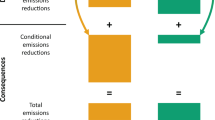Abstract
This paper aims to apply game theory matching mechanisms to international climate change negotiations using numerical analysis in order to overcome the free-riding problem without a central authority. The analysis found that the mechanisms can increase the reduction by 2.5 times compared to the case without the mechanisms. It also demonstrates that coupling it with an emission trading scheme could reduce total abatement costs, and improve countries’ payoffs substantially. Matching mechanisms could be tabled in international climate change negotiations based on the conditional pledges which are currently proposed by the European Union and a few other countries.



Similar content being viewed by others
References
Asheim GB, Holtsmark B (2009) Renegotiation-proof climate agreements with full participation. Environ Res Econ 43:519–533
Asheim GB, Froyn CB, Hovib J, Menz FC (2006) Regional versus global cooperation for climate control. J Environ Econ Manag 51:93–109
Barrett S (2001) International cooperation for sale. Eur Econ Rev 45:1835–1850
Barrett S (2003) Environment and statecraft. Oxford University Press, Oxford
Boadway R, Song Z, Tremblay JF (2007) Commitment and matching contributions to public goods. J Public Econ 91:1664–1683
Boadway R, Song Z, Tremblay JF (2011) The efficiency of voluntary pollution abatement when countries can commit. Eur J Political Econ 27:352–368
Buchholz W, Cornes RC, Rübbelke D (2011) Interior matching equilibria in a public good economy: an aggregative game approach. J Public Econ 95:639–645
Climate Analytics, EcoFys and Potsdam Institute for Climate Impact Research (2011) Cancun climate talks: keeping options open to close the gap. Climate action tracker briefing paper. http://www.climateactiontracker.org/briefing_paper_cancun.pdf. Accessed 25 Nov 2012
Danziger L, Schnytzer A (1991) Implementing the Lindahl voluntary-exchange mechanism. Eur J Political Econ 7:55–64
De Vit C, Höhne N (February 2012) Why the Durban outcome is not sufficient for staying below \(2^{\circ }C\). Ecofys policy update. Issue III
Dellink R, Altamirano-Cabrera J-C, Finus M, van Ierland E, Ruijs A, Weikard H-P (2004) Empirical background paper of the STACO Model, Wageningen University. http://www.enr.wur.nl/uk/staco. Accessed 10 Apr 2012
Ellerman AD, Decaux A (1998) Analysis of post-Kyoto CO\(_2\) emissions trading using marginal abatement curves. MIT joint program on the science and policy of global change. Report No. 40. MIT, Cambridge
Fankhauser S (1995) Valuing climate change: the economics of the greenhouse. Earthscan, London
Finus M, Altamirano-Cabrera JC, van Ierland E (2005) The effect of membership rules and voting schemes on the success of international climate agreements. Public Choice 125:95–127
Germain M, van Steenberghe V (2001) Constraining equitable allocations of tradable greenhouse gases emission quotas by acceptability, Discussion paper 2001/5. COREUniversité Catholique de Louvain, Louvain-la-Neuve
Goodman J (2012) Climate change and global development: towards a post-Kyoto paradigm? Econ Labour Rel Rev 23(1):107–124
Guttman JM (1987) A non-Cournot model of voluntary collective action. Economica 54:1–19
McGinty M (2006) International environmental agreements among asymmetric nations. Oxf Econ Pap 59:45–62
Nagashima M (2010) Game-theoric analysis of international climate agreements: the design of transfer schemes and the role of technological change, Thesis. Wageningen University, Wageningen
Nagashima M, Dellink RB, van Ierland E (2006) Dynamic transfer schemes and stability of international climate coalitions, Discussion Paper No. 23, Working paper Mansholt Graduate School
Nordhaus WD (1994) Managing the global commons. MIT Press, Cambridge
Tol RSJ (1997) A decision-analytic treatise of the enhanced greenhouse effect (PhD. Thesis) Vrije Universiteit, Amsterdam
Underdal A, Hovi J, Kallbekken S, Skodvin T (2012) Can conditional commitments break the climate change negotiations deadlock? Int Political Sci Rev 33:475
United Nations Framework Convention on Climate Change (2011) The Cancun agreements: outcome of the work of the ad hoc working group on long-term cooperative action under the convention, COP decision, 1/CP.16. http://unfccc.int/resource/docs/2010/cop16/eng/07a01.pdf. Accessed 25 Nov 2012
United Nations Framework Convention on Climate Change (2012a) Appendix I—quantified economy-wide emissions targets for 2020. http://unfccc.int/meetings/copenhagen_dec_2009/items/5264.php. Accessed 25 Nov 2012
United Nations Framework Convention on Climate Change (2012b) Establishment of an ad hoc working group on the Durban platform for enhanced action, COP decision 1/CP.17. http://unfccc.int/resource/docs/2011/cop17/eng/09a01.pdf. Accessed 25 Nov 2012
Author information
Authors and Affiliations
Corresponding author
Rights and permissions
About this article
Cite this article
Kawamata, K., Horita, M. Applying Matching Strategies in Climate Change Negotiations. Group Decis Negot 23, 401–419 (2014). https://doi.org/10.1007/s10726-013-9354-6
Published:
Issue Date:
DOI: https://doi.org/10.1007/s10726-013-9354-6




